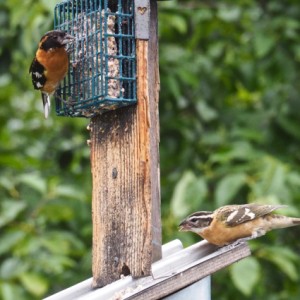An Unusual Trio
Our resident birds seem to have had a very good year for raising their chicks, as all of a sudden there seem to be many fledglings trying to figure out how to access the two bird feeders in the back yard.
The fledgling on the top left is a Hairy Woodpecker, probably a female. I've never seen different species share a feeder before, but these three got along well. Also on the top is either an immature male or a female Black-Headed Grosbeak, and below is a fledgling female of the same species. She soon figured out how to get up to where the food was too!
I've put a photo of an adult pair of Black-Headed Grosbeaks feeding earlier today in the extras so you can see how their coloring intensifies as they mature.
Black-Headed Grosbeaks have big, conical bills, very useful for cracking the shells of sturdy seeds and nuts. They also eat fruits and insects.
As is my wont, I did some online research about these birds, and learned, among other things, that (1) they breed from subalpine forests to desert riparian zones throughout western North America, from southwestern Canada (near us) to southern Mexico; (2) both the males and females sing; and (3) males share nest duties about equally with females.
They spend the winter in central Mexico, along with monarch butterflies. Black-Headed Grosbeaks are among the few birds that can eat the butterflies, as toxins in the monarchs make them poisonous to most birds.
On this excellent website, I was amazed to read that "The oldest known Black-Headed Grosbeak was a male, at least 11 years, 11 months old, when it was recaptured and rereleased during banding operations in Montana." I had no idea that small birds like these could live that long!
Blip 2016


Comments
Sign in or get an account to comment.


